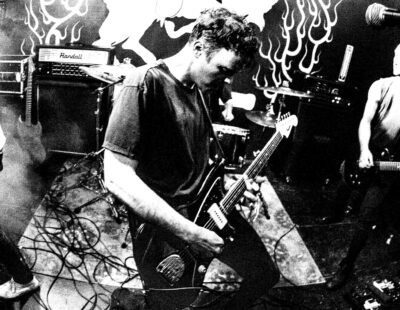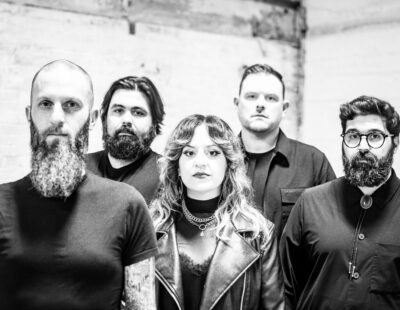Quick test: go check your music shelf or your iTunes. How many metal albums have some kind of mention of the Devil? A third? How did that symbolism get there in the first place? Why is it so powerful, and so enduring?
In the second installment of blues into metal, we’re honored to have bluesman and blues historian Adam Gussow from the University of Mississippi by way of Manhattan. While a student at Princeton, Gussow was a street musician with the blues duo Satan and Adam. He’s a gifted harmonica player who encourages that blues be thought of as a living idiom rather than a set of songs that should be learned and repeated.
He’s also studied and read a lot about this whole Devil thing. Gussow’s next book Beyond The Crossroads: The Devil And The Blues Tradition is in the works. Gussow talked to dB about the Devil in popular American music and the parallels between blues and metal.
How did the symbol and the figure of Satan become prominent in blues music?
The figure of Satan has no real presence in blues music. The Devil certainly has a presence in a number of ways. Now, I’m part of a contemporary blues duo called Satan and Adam and I play with an African American from Mississippi named Sterling Magee who calls himself Mr. Satan. The truth is that with one exception Satan doesn’t show up in blues music. The Devil certainly does. I have 160 songs on my MacBook with the Devil in them. Satan is, of course, all over black spirituals. There’s one incredibly important exception in blues which is Robert Johnson’s “Me and The Devil Blues.” Johnson said: “Early this morning you knocked upon my door and I said, hello Satan, I believe it’s time to go.”
It seems like nomenclature. A lot of people think of the Devil and Satan as interchangeable.
Well, if he is then why does the name Satan never show up in the blues? Why is it always the Devil with one exception? My argument for why he shows up in that (Johnson) song is that the youth of the (Mississippi) Delta at the time did not believe in the Devil. Everybody complained about it. Hortense Powdermaker wrote a book called After Freedom about how people were complaining that the young people in the Delta didn’t believe in religion. They didn’t believe in the Devil, God or hellfire and brimstone. It was like younger people could no longer be scared by the talk from the ministers.
When you look at interviews with blues musicians from the Delta they will tell interviewers that blues is not the Devil’s music. Snooky Pryer said “you should see what this music has done for me. It’s not the Devil’s music.” That was the slander that old folks laid on it. It was young people’s music. People cruised to it, drank to it, fucked to it, fought to it. Older generations got scared. It was moral condemnation, just like what happens with heavy metal and death metal. People get nervous and say “this is out of control.” It’s what they were saying in Robert Johnson’s time. Johnson used the word in the song because he knew it was going to upset old people and he knew he would earn cool points from the younger generation.
There are people in the metal scene that say they worship the Devil and are completely serious. But there’s no doubt that for some people it’s also about marketability in rebellion, the ultimate taboo. So this has been going on for 100 years in American music?
Robert Johnson, unlike 90 percent of blues musicians, was willing to associate himself with the Devil in a song to give himself a rock and roll edge. Most musicians weren’t willing to do that. But the Devil still shows up in all sorts of blues songs. There’s a long history of crossroads encounters but none of them take place in Mississippi. They take place in Maryland and North Carolina and New Jersey.
Let’s go right to the source: Peetie Wheatstraw. People tend to miss the Elijah Muhammad/Nation Of Islam side of the Devil in the blues. I have a chapter on it. There’s a whole category of blues songs that take off on spirituals, which often have Satan in them. This strain within the blues is about what the white man has created in the South with slavery. That shows up all over. Peetie Wheatstraw has about 164 recordings and on 162 of them he’s identified as the “Devil’s Son In Law.” On others he’s identified as the “High Sheriff From Hell.”
Wheatstraw wasn’t trying to align himself with the Devil as much as he was trying to say he was bad. I’m the biggest badass around. If you are a black blues performer and know a prime lynching offense is anything to do with a white woman then to be daring or fearless say you are the Devil’s son in law. You are basically undercutting the white Devil. There’s an underground racial wrestling match going on. Honeyboy Edwards said Wheatstraw had a white woman on his arm and a little white dog on a chain and would walk down the center of East Saint Louis. It doesn’t take a lot to figure out what he was telling his audience. He had whiteness on a chain. It was sort of like Black Snake Moan where Samuel Jackson has Christina Ricci on a chain. There’s a charged dialogue going on.
Records back then were called race records. Was there pushback from the core audience for this music or the white executives who pushed it? Or did it move blues records?
No, it was quite the reverse. Stephen Calt’s book on Skip James I’d Rather Be The Devil talks about how he recorded the song “Devil Got My Woman.” It was out a few weeks later and advertised with Devil imagery. It put (James) off a little bit.
White record executives thought it was great. They always suspected some black folks were evil and in touch with this stuff and superstitious. They thought it was a great way to market it; there was no pushback at all. Black people were seen in most white minds as immoral and licentious. The whites who made money off this thought it was great.
In some ways, this marketing and the selling of the Devil in music almost perpetuated existing racial stereotypes.
You’re absolutely right. Of course, there was always a vein of white southern Evangelicalism which is very judgmental and didn’t like the Devil anywhere. That shows up when rock and roll turns up — that it’s the Devil’s music.
When I started to look at the history of the Devil and blues there was something that preceded the guitar; it’s the fiddle. This takes us back to Paganini and European ideas about people with incredible talent being in touch with the Devil (Eds note: also see Jimmy Page). There was an idea very early on that African slave fiddlers were playing evil music. But it didn’t really enter black music until the 1830s and 40s when black culture got internally divided.
In the 1700s, plantation masters were not terribly religious and had no problem with hoedowns and fiddlers. At a certain point the South got a lot more religious. Slaves started converting. Frolics became seen as something you don’t want to encourage. Black culture up until Emancipation was divided and that increased in the years after Emancipation. Slave culture was initially very dry; there’s a lot of scholarship on this. Slaves didn’t have a lot of spending money and didn’t have time or cash needed for alcohol. That changed when blacks were freed. There was a movement to uplift – especially among the middle class. Churches were formed and you could be a minister and make money. Then, there were guys who formed juke joints because they could open a bar and make money. That led to secular black music. John Lee Hooker had a father who was a minster. The phrase the Devil’s music applies because there was a great bifurcation in black culture. There were ministers trying to build churches and blues musicians and juke joints on the other side. Both of them were making money.
Johnnie Billington is an old African American bluesman from the Delta. He has a school and teaches blues. He’s very stern. I played a gig with him once on a street. At one point I said to him: “Mr. Johnnie, I want to ask a question. I heard about how blues is the Devil’s music.” His eyes got fiery and he said “No, No, No!” He said: “Let me tell you this. By the time the minister gets his hand on the dollar the bluesman has already had two chances at it.” I knew what he meant. It was all about competition.
How does blues and the symbol of the Devil make the leap from the Delta and Chicago to rock and roll music? Was the British Invasion just copying things they heard on old blues music? How does it get into white popular music?
It comes from two different directions. First, it comes from white Southern condemnation. You need to go back before rock and roll to the jazz age. There was moral condemnation from black and white ministers. In the 1920s, women were flappers and smoking; black and white folks mingled. These places were called Devil’s Dance Dens. What really set the religious guys off was the dances that came out of juke joints and were learned by whites. Fats Waller has a song called “There’s Going To Be The Devil To Pay.” He was playing a role but had a black minister father in the south.
These weren’t people who believed in the Devil but referred to him irreverently, which freaked out white and black religious folks. That moral condemnation continued. The Devil’s music aspersion was then cast on rock and roll because it’s where whites and blacks were getting together. For them it was the Devil’s music because it was integrationist.
The other side is different. That’s the Eric Clapton/Mick Jagger “Sympathy For The Devil” side. That’s white British rockers captivated by a gothic mythology and the idea of the crossroads. They didn’t know African American musicians in social context and just listened to the records. They thought it was astonishing music and loved the story about how Johnson went away for six months, sold his soul and became incredibly good. There’s a romanticism that British rockers put on the music. They had very little exposure to living, breathing black musicians. Sonny Boy Williamson and Big Bill Broonzy came to Europe but (most British rockers) didn’t know the music in context.
For the heavy metal community the genesis album is Black Sabbath’s debut which came out in 1969. Satanic themes are all over it. “NIB” is about a romantic relationship with the Devil and the eponymous track is – depending on your point of view – about meeting Satan. So did this imagery get into heavy metal music through romanticization?
I don’t know enough about the history of metal to say if these were affective investments. What I do think is that the way the Devil shows up in the blues is a lot different than how the Devil shows up in metal music. I come from the position that the parallels are probably overstated. But there are certain parallels. There’s the idea of an outside class. Blues people were a self-selected subculture. I’d say there is a similar outsider consciousness to the metal community, with the Devil as the paradigm of the outsider. The Devil is an antagonist. For that reason the Devil was also a useful figure for African Americans who felt excluded from a larger culture.
I think people makes the comparison because there are so many common musical idioms. There would be no heavy metal without blues.
There’s a really interesting place where the two come together. There’s a movie called Crossroads. I happen to like Steve Vai. Is he o.k. with metal guys? (laughs). Is he too pop?
I think Tony Iommi would get the top slot in heavy metal.
(Laughs). Well, let’s get back to Crossroads. The Ralph Macchio character has a black blues playing elder. Then there’s the Steve Vai figure, Jack Butler. The script is the work of a white screenwriter, John Fusco. I view Crossroads, which came out in 1986, as the way the white world was trying to make sense of what Steve Ray Vaughn had wrought. There’s anxiety in the blues world about having a white hero, a guy reinvigorating the blues when blacks aren’t interested in it. There’s a way that the music has been inherited by whites, at least in terms of popularity.
In that battle scene we see two kinds of white blues guitar playing. The Jack Butler character is degraded because it’s theatrical and, according to the movie, it’s metal! (laughs) There are staged grimaces and virtuosity without funk. Next to it is Ralph Macchio. Next to the metal version his blues come off as more authentic.
What’s fascinating is that Macchio wins (the duel) by bringing in Paganini. It’s obviously not blues played in a bluesy way. He pulls it out when Vai has him beat. What’s left when you’ve gotten rid of the degraded blues metal guy and you have a white guy who learned to play blues? It kind of makes whites feel better about their affective investment; we too can play something deep and improvisationally brilliant.
You talked about the battle between blues and metal but I think blues has lost an audience because people think of it as a relic. Even if it’s brilliant it seems like something people watch in a nice club.
There’s far too much glomming on to the past, an overinvestment in the tradition, by white blues afficionados. That’s the reason I really like Jason Ricci (see our first installment). He knows the history beautifully and can play any of those styles. But he’s also dared to leap a little higher and create a new blend. I’ve always assumed that there is a deep anxiety among whites about what they are doing playing blues. If they get away from like a B.B. King or Big Walter Horton they aren’t playing blues. I don’t have that anxiety because I played with Sterling who insisted we create new stuff, even if he was in the blues tradition. But I certainly don’t hew too deep into the tradition. I imagine metal has its own problems? As things become institutions they just keep looking back at their own origins.
One of the big movements in 80s metal was thrash. Now there are a group of musicians trying to sound like the early 80s. So there’s definitely revisionism.
That must be difficult in metal where there’s a lot of emphasis on speed and shredding. Once you’ve gone that fast, where do you go after all that shredding? (laughs)
Make it as slow and heavy as possible.
(laughs). Well, that’s cool, too.
We have metal artists today that bring road kill on stage. Models have been crucified. What would the blues musicians think of these antics?
(laughs). The equivalent would be Screamin’ Jay Hawkins rising out of a casket. There’s a certain element of staginess in blues. It’s always had a place. Now, they seem to make a fetish of a guy playing on a back porch. But there’s not a tradition in the blues of negation for the sake of pure negation, doing the least healthy, most sickening thing we can to shock people. There’s none of that in the blues tradition. Life was too hard and you didn’t want to make it that hard on your audience. You wanted to revivify them. But both of them have rituals. There’s an idea of being a subculture doing what it does; that’s very strong in both idioms. I think your readers could appreciate that from a metal perspective.
Get in touch with Adam Gussow here. Disclaimer: He cannot broker crossroads deals.
Adam and Blues Into Metal encourage everyone to know their history and track down some of the amazing music and books referenced above.






